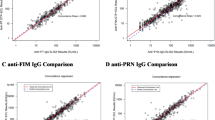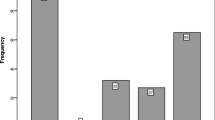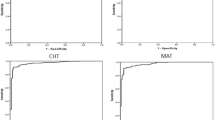Abstract
Determination of immune status of patients to diphtheria toxin is based mainly on the results of commercially available ELISA kits. The aim of the present study was to compare the results obtained by ELISAs from seven different manufacturers: Mikrogen, Immunolab, Sekisui Virotech, NovaTec, Virion\Serion, IBL International and Euroimmun. All assays were performed according to the manufacturers’ instructions. The concentrations of the anti-diphtheria toxin antibodies in 72 serum samples were calculated on the basis of curves constructed from standards supplied by manufacturers and the new reference material—International Standard for Diphtheria Antitoxin (10/262). The repeatability and reproducibility of all the ELISA kits tested were good. Number of sera with concentrations of the anti-diphtheria toxin antibodies below the WHO-recommended level of protection (0.1 IU/ml) were dependent on the ELISA used: Mikrogen, 20/72 samples (27.7 %); Immunolab, 11/72 samples (15.3 %); Sekisui Virotech, 0/72 samples (0 %); NovaTec 18/72 samples (25.0 %); Serion 12/72 samples (16.7 %); IBL International, 7/72 samples (9.7 %); and Euroimmun, 17/72 samples (23.6 %). However, the results obtained in particular ELISAs, with the exception of Sekisui Virotech, were much more consistent when the concentrations of the anti-diphtheria toxin antibodies in 72 sera measured by using curves constructed from the International Standard 10/262. The data obtained clearly demonstrated that manufacturer-dependent differences between anti-diphtheria IgG ELISA kits exist. The differences in recommendations accepted by the individual manufacturers together with differences shown in our studies in sensitivity greatly affect the clinical interpretation of results.
Similar content being viewed by others
References
Wagner KS, White JM, Lucenko I, Mercer D, Crowcroft NS, Neal S, Efstratiou A (2012) Diphtheria in the postepidemic period, Europe, 2000–2009. Emerg Infect Dis 18:217–225
Tiwari TSP (2012) Diptheria. In: Brunette GW (ed) CDC health information for international travel 2012—yellow book. Oxford University Press, New York. http://wwwnc.cdc.gov/travel/yellowbook/2012/chapter-3-infectious-diseases-related-to-travel/diphtheria.htm. Accessed 21 January 2013
Marlovits S, Stocker R, Efstratiou A, Broughton K, Kaider A, Vecsei V, Wiedermann G, Kollaritsch H (2001) Seroprevalence of diphtheria immunity among injured adults in Austria. Vaccine 19:1061–1067
Mossong J, Putz L, Shkedy Z, Schneider F (2006) Seroepidemiology of diphtheria and pertussis in Luxembourg in 2000. Epidemiol Infect 134:573–578
Sheifele DW, Ochnio JJ (2009) The immunological basis for immunization series. Module 2: diphtheria update 2009. WHO, Geneva
Di Giovine P, Pinto A, Olander RM, Sesardic D, Stickings P, Berbers G, Neal S, Efstratiou A, Paberza R, Dauksiene S, Bujko M, Detcheva A, Joks U, Levent B, von Hunolstein C (2010) External quality assessment for the determination of diphtheria antitoxin in human serum. Clin Vac Immunol 17:1282–1290
Stickings P, Rigsby P, Coombes L, von Hunolstein C, Ralli L, Pinto A, Sesardic D (2012) Collaborative study for the calibration and commutability assessment of the proposed 1st International Standard for Diphtheria Antitoxin Human. WHO/BS/2012.2192, Geneva. http://www.who.int/biologicals/expert_committee/BS_2192_1st_International_Standard_Diphtheria_Antitoxin_Human.pdf. Accessed 21 January 2013
Faruq A, Dadson L, Cox H, Alcock F, Parker AR (2010) Technical and diagnostic performance of five commercial anti-diphtheria toxoid IgG enzyme-linked immunosorbent assay kits. Clin Vac Immunol 17:1612–1616
Vitek CR, Wharton M (1998) Diphtheria in the former Soviet Union: reemergence of a pandemic disease. Emerg Infect Dis 4:539–550
Galazka A (2000) The changing epidemiology of diphtheria in the vaccine era. J Infect Dis 181(suppl 1):S2–S9
De Vries E (2006) Patient-centred screening for primary immunodeficiency: a multi-stage diagnostic protocol designed for non-immunologists. Clin Exp Immunol 145:204–214
Bonilla FA, Bernstein IL, Khan DA, Ballas ZK, Chinen J, Frank MM, Kobrynski LJ, Levinson AI, Mazer B, Nelson RP, Orange JS, Router JM, Shearer WT, Sorensen RU (2005) Practice parameter for the diagnosis and management of primary immunodeficiency. Ann Allergy Asthma Immunol 94(suppl 1):S1–S63
Galazka AM, Robertson SE (1996) Immunization against diphtheriae with special emphasis on immunization of adults. Vaccine 14:845–857
van Gadeldonk PGM, von Hunolstein C, van der Klis FRM, Berbers AM (2011) Improved specificity of a multiplex immunoassay for quantitation of anti-diphtheria toxin antibodies with the use of diphtheria toxoid. Clin Vac Immunol 18:1183–1186
Melville-Smith M, Balfour A (1988) Estimation of Corynebacterium diphtheriae antitoxin in human sera: a comparison of an enzyme-linked immunosorbent assay with the toxin neutralization test. J Med Microbiol 25:279–283
Acknowledgments
This work was funded by the National Science Centre under project no. DEC-2011/01/B/NZ7/04370.
Conflict of interest
The authors declare that they have no conflict of interest.
Author information
Authors and Affiliations
Corresponding author
Rights and permissions
About this article
Cite this article
Zasada, A.A., Rastawicki, W., Śmietańska, K. et al. Comparison of seven commercial enzyme-linked immunosorbent assays for the detection of anti-diphtheria toxin antibodies. Eur J Clin Microbiol Infect Dis 32, 891–897 (2013). https://doi.org/10.1007/s10096-013-1823-y
Received:
Accepted:
Published:
Issue Date:
DOI: https://doi.org/10.1007/s10096-013-1823-y




